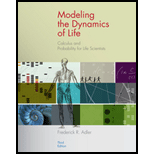
Concept explainers
To find: The long term dynamic in each of the cases and find one that will beat other every time and displays 2:1 AV block and which show some sort of Wenckebach phenomenon.
Answer to Problem 7E
The value of “c” when a little above the threshold value of 0.667 to maintain the equilibrium, the heart, beat 12 times and it builds up to a higher and higher potential. Eventually, the potential is so high that the AV node is not able to recover and the heart fails to beat. As soon as the beat fails the potential drops and the process starts again, this phenomenon is known as the Wenckebach phenomenon.
Explanation of Solution
Given:
The given parameter is,
Calculation:
The potential of the AV node
Then,
For
For
To translate the description into discrete dynamical system we must write
Thus, the two cases is summarized as,
Since
Now setting
The equilibrium exist only if the heart is indeed ready to beat when the next signal comes or if,
Thus, the equilibrium exists only if
Thus, there are two conditions, one is of 2.1 AV block where the heart beats only with every other stimulus and the other is the Wenckebach phenomenon where the heart beats normally for a while and then it skips the beat and then resumes normal beating and repeats cycle.
Consider the potential just after the beating is
If the potential after the two full cycles comes back exactly to where it was started the heart beats with every signal that produces 2:1 AV block.
The expression for the updated potential after the two cycle’s matches the original potential if
Then, the solution is,
The case when the inequalities are satisfied.
As the inequality
Thus, it is not a case of 2:1 AV block.
Compute the condition on c for the existence of the equilibrium.
The equilibrium is,
Then,
Thus, the value of “c” when a little above the threshold value of 0.667 to maintain the equilibrium, the heart, beat 12 times and it builds up to a higher and higher potential. Eventually, the potential is so high that the AV node is not able to recover and the heart fails to beat. As soon as the beat fails the potential drops and the process starts again, this phenomenon is known as the Wenckebach phenomenon.
Want to see more full solutions like this?
Chapter 1 Solutions
Modeling the Dynamics of Life: Calculus and Probability for Life Scientists
- Algebra & Trigonometry with Analytic GeometryAlgebraISBN:9781133382119Author:SwokowskiPublisher:Cengage
 Big Ideas Math A Bridge To Success Algebra 1: Stu...AlgebraISBN:9781680331141Author:HOUGHTON MIFFLIN HARCOURTPublisher:Houghton Mifflin Harcourt
Big Ideas Math A Bridge To Success Algebra 1: Stu...AlgebraISBN:9781680331141Author:HOUGHTON MIFFLIN HARCOURTPublisher:Houghton Mifflin Harcourt

